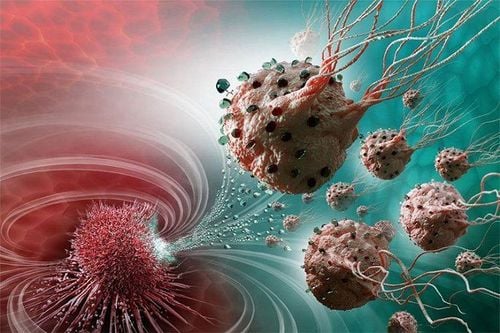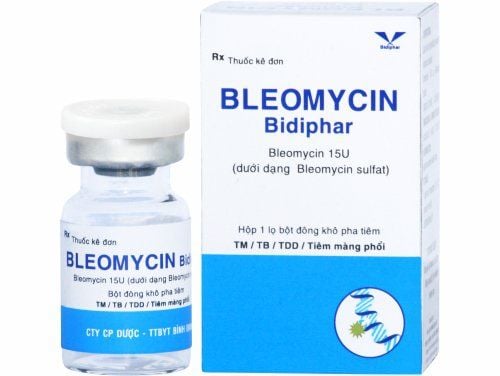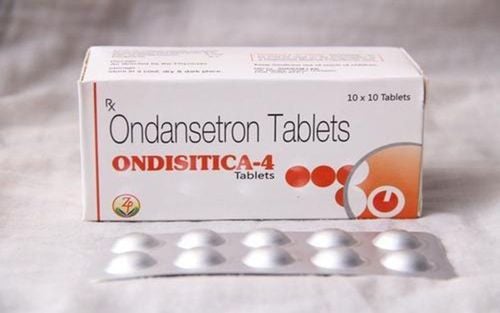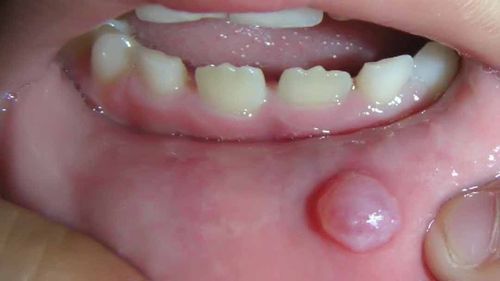This is an automatically translated article.
The article is written by Master - Doctor Mai Vien Phuong - Head of Gastrointestinal Endoscopy Unit - Department of Medical Examination and Internal Medicine - Vinmec Central Park International General Hospital.Mixed endothelial tumors of the colon and rectum are rare, poorly understood entities that include a heterogeneous range of tumors with multiple combinations leading to tumors with acute malignant potential. high, medium or low. In the following article, we will learn more about the pathology of these tumors.
Abbreviation: MEEN: Mixed Endocrine Epithelial Tumor; MANEC: Mixed neuroendocrine adenocarcinoma; MANET: Mixed neuroendocrine adenoma; NET 1: Grade 1 neuroendocrine tumor; NET2: Grade 2 neuroendocrine tumor; NET3: Grade 3 neuroendocrine tumor; NEC: Neuroendocrine carcinoma. MiNEN: Mixed non-neuroendocrine neoplasm.
1. Pathology of mixed endothelial tumors
Most high-grade and medium-grade tumors were large and bulky with a mean tumor size of 52.2 mm with 88.1% presenting as advanced tumors with increased depth of invasion as T3-4 lesions. The macroscopic appearance of the neoplastic lesions resembles colorectal adenocarcinoma with varying macroscopic manifestations, including polypoid or ulcerative mass with raised edges or large fungal mass with a tendency to prone to serosa bleeding and invasion of adjacent structures, ulcerative proliferation, tight encapsulation with superficial and/or plaque-like epithelial atrophy with diameter variation from 0.5 to 14 cm .Diffuse necrosis and spasm of the intestinal lumen are often very evident. In general, these tumors form a semicircular mass with deep ulceration, occupying the entire lumen, although fatty lesions or prominent polypoid masses occupying the lumen may be seen.
2. Complications
Large tumors can sometimes cause intussusception. Macroscopic tumor perforation, with adhesions to surrounding organs/structures, infiltration of the peritoneum, and pericolon fat can also be observed. The cut surface of the tumor often shows white lesions, indistinct envelopes, with infiltrative margins. Localized necrosis and foci of hemorrhage are not uncommon. However, it is important to note that there is no single overall feature to distinguish mixed endothelial carcinoma from carcinoma alone or squamous cell, mucinous carcinoma. In contrast, the overall appearance of low-grade tumors is usually an adenomatous polyp: Tubular/villi/villiform in association with a random endocrine tumor or neuroendocrine carcinoma. detected only microscopically (very rare).
3. Microscopic image
Microscopically, the two components of a mixed tumor are epithelial and endocrine, of which each must be at least 30% according to current WHO guidelines. In a recent systematic review by Frizziero et al., the two components were present in equal proportions in 27.9% of cases. While in the remaining 72.1%, one of the components dominates; the neuroendocrine component accounted for 42.2% and the non-neuroendocrine/epithelial component accounted for 29.9%.The neuroendocrine component seen in these mixed lesions was a high-grade NEC or NETG3 with 4.3% and a low-grade component of NET1 or NET2 with 3.1%. More recent studies question the validity of this 30% inclusion criterion because mixed tumors with less incidence can still have a significant prognosis. This is particularly the case when identifying NECs in poorly differentiated carcinomas, where recognition of this component has significant prognostic value as these cases would require more complex management as described above. discussed later.
WHO has suggested, evaluated and classified each histological component separately but the authors recommend that the percentages of all components of mixed tumors be reported, even with less than 30% and should all be classified as mixed endothelial tumors. The authors suggest that it is important to explore alternative thresholds of 10% or 20% because even a small concentration of NEC can be associated with invasive and metastatic activity.
Most neuroendocrine tumors (NENs) in high-grade cancer are PDNEC (Poorly Differentiated Neuroendocrine Carcinoma) or large cell (82.2%), or small cell (17.8%) was associated with an epithelial tumor without a neuroendocrine component and usually NOS adenocarcinoma or mucinous ring cell carcinoma ( 92.2%), although squamous cell carcinoma (2.5%) and other variants such as adenomas (<1%), AFP-negative hepatocellular carcinoma (<1%) have also been reported. reported.
Histologically, the poorly differentiated neuroendocrine component resembles small or large cell NEC tumors. The small cell subtype has cells arranged in nests or in a diffuse fashion, with a small amount of cytoplasm, fusiform identity with granular chromatin and indistinct nucleoli. High eigenvalues are typically 20 - 80 integers / 10 HPD. Meanwhile, high-grade non-small cell morphology includes cells with abundant cytoplasm, vesicular nucleus, and convex nuclei.
Prominent cancer cell differentiation represented by large cells with marked eosinophils has also been reported in a mixed tumor of the transverse colon.
Hermaphroditic tumors are distinguished by a different immunological pattern in which both exocrine and neuroendocrine features are expressed in the same cell. All neuroendocrine components were classified according to WHO criteria based on mitotic index and KI67 proliferation into well-differentiated neuroendocrine tumors G1, G2 and G3 and neuroendocrine cancers. poorly differentiated neurons of the small or large cell type. Microvascular invasion and peridural tumor associated with geographic necrosis, vascular thrombosis, infarction, and ischemia may also be present in the adjacent bowel specimen.
The most important factor for improving the outcome of MANEC remains an early and accurate diagnosis with adequate histopathological examination to determine the presence of two components in the same tumor. This often requires a thorough search for morphologically different areas on haematoxylin and eosin-stained sections and liberal use of immunohistochemical markers. Immunohistochemical tests are an important foundation for the identification of a large number of these mixed tumors, ranging from adenomas or adenocarcinomas with some neuroendocrine cells to endocrine tumors. neuropathic with focal exocrine/epithelial elements.
Pathologists must pay attention to morphology and actively capture immunohistochemical staining. The selection of appropriate immunohistochemical stains is essential for timely accurate diagnosis. Above all, pathological suspicion and clinical awareness are crucial for the correct diagnosis of these mixed tumors. Although small cell neuroendocrine carcinoma can be easily distinguished from adenocarcinoma by hematoxylin-eosin staining, it is often difficult to distinguish large cell neuroendocrine carcinoma from hematoxylin-eosin slide adenocarcinoma, leading the pathologist to overlook these entities.

Reports of both exocrine/epithelial and endocrine components showing positivity for cyclin D1, p53 and beta-catenin were also noted. Interestingly, beta-catenin showed a very high positivity rate in the neuroendocrine component. E-cadherin, villi and CgA-positive MANECs have also been reported in the literature. Mucin secretion can be demonstrated by periodic acid Schiff reagent. In MANECs associated with squamous cell carcinoma, the squamous cell component can be highlighted by positivity for CK5/6 and CDX2. Recently CD133, a marker of cancer stem cells, was reported to be positive in 64% of MANECs of the gastrointestinal tract, and was associated with tumor aggressiveness. Adenocarcinoma or squamous cell carcinoma is known to arise from the mucosa, while the neuroendocrine component usually develops from the deeper layer of the colon wall.
In this setting, endoscopic-guided biopsies may not sample the deep neuroendocrine component, thus potentially leading to misdiagnosis in biopsy specimens. In the case of more than one diagnostic sample, the rate of suspicion or diagnosis of MiNEN was observed in 36.1%. Depending on the stage of the disease, the tumor may involve the entire thickness of the intestinal wall or even involve nearby organs. Histologically, a glandular lesion may be seen with solid nests or sheets of tumor cells with large cystic nuclei with prominent nuclei. In the case of low-grade MANETs, including mixed adenocarcinomas, the dysplastic glandular component usually occupies the periphery of the polyp extending to the pedicle, whereas the carcinoid/neuroendocrine component is usually found centrally. center of the polyp. . The glandular component consists of abnormal epithelial cells with enlarged nuclei, coarse chromatin, forming irregular glands. Rare cases of adenomatous polyposis with neuroendocrine carcinoma have been reported to be rapidly progressive and often morphologically similar to that of an advanced adenocarcinoma, raising questions about the MANET advanced evolution.
4. The most important factor determining the predisposition to malignancy

Please dial HOTLINE for more information or register for an appointment HERE. Download MyVinmec app to make appointments faster and to manage your bookings easily.
References: Kanthan R, Tharmaradinam S, Asif T, Ahmed S, Kanthan SC. Mixed epithelial endocrine neoplasms of the colon and rectum – An evolution over time: A systematic review. World J Gastroenterol 2020; 26(34): 5181-5206 [PMID: 32982118 DOI: 10.3748/wjg.v26.i34.5181]













